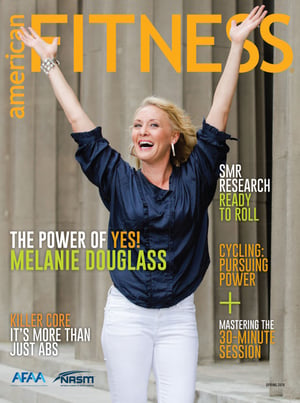 Originally appeared in the 2018 spring issue of American Fitness Magazine
Originally appeared in the 2018 spring issue of American Fitness Magazine
It all started years ago when a longtime client of mine loved to tell anyone within earshot how much she hated to work out.
So I tried an experiment and chopped her workout in two. Soon, the same woman who could barely stand a weekly 60-minute workout could not get enough of two half-sessions a week. Her enjoyment and adherence spiked, results improved exponentially, and the negative views on fitness evaporated. I used to have a lot of clients like her.
Their once-a-week, 60-minute sessions weren’t delivering the results they signed up for—mainly because that one workout was the only exercise they were getting all week. Other clients would cancel over busy schedules or tight budgets.
I started thinking that there had to be a way to make the programs much more fun while keeping the clients more engaged. How could I get them to come to the gym more often and maintain focus during their sessions?
I found my answer in one succinct sentiment: “I can do anything for 30 minutes.”
Before long, I converted all my weekly 60-minute clients into 30-minutes-twice clients—triggering a 60% increase in training revenues for my business. And that’s how my 30-minute model was born. It’s an excellent fit for clients who are busy, cash-strapped or both. Plus, it’s easy to do as long as you understand why it works so well and know some of the nuts and bolts of getting it up and running.
If you are looking for some tips for strengthening your in-person or online personal training business, read below.
Why Clients Need the 30-Minute Model
A primo client walks in one day and drops the bomb: “I’m sorry, Super Trainer. I really enjoy the workouts and the facility, but I need to take a break. I’m really short on time and can’t fit in our usual workouts.”
Don’t you hate that? Your business is finally going in the right direction, and then bang—a great client wants out. My 30-minute model works because I designed it to turn this kind of scenario around. Think about it from your client’s perspective. In our time-strapped society, any number of stressors can cause a training hiatus:
WORK. More and more clients work from home, leading to a relentless, activity-driven lifestyle. They are working on projects with the stress of deadlines and obligations 24 hours a day!
TECH. The social media boom produces a constant influx of notifications and a crush of pressure to keep up with the posts and tweets of friends, family and co-workers.
PERCEPTION. To the average sedentary fitness participant, becoming fit feels like climbing a mountain. With all the other pressures from work, social media and more, it’s far too easy to push an exercise routine to the bottom of the priority list.
Frequently Asked Questions About the 30-Minute Model
Here are some common questions I am asked about the 30-minute model:
HOW DO YOU DECIDE WHICH ACTIVITIES A CLIENT NEEDS, AND THEN HOW DO YOU RECOMMEND THEM?
Answer: The 30-minute model works best when focused on frequency and creativity. A one-on-one, quality assessment will guide programming, just as it would in a 60-minute model.
DO YOU GIVE CLIENTS “HOMEWORK” FOR DAYS YOU DON’T MEET WITH THEM? WHAT ARE SOME EXAMPLES?
Answer: The model naturally lends itself to high-intensity interval training, which utilizes multi joint movements. If clients work hard enough, they’ll need the time away from you for recovery. However, encourage them to do any additional activities they find enjoyable. If my clients have specific performance goals or needs, I offer a supplemental programming option; you could do the same.
DO YOU PERIODIZE SESSIONS OR PERHAPS FOCUS ONE ON UPPER BODY AND THE NEXT ON LOWER? OR IS IT ALWAYS TOTAL-BODY?
Answer: Let your assessments guide programming, and offer different models based on clients’ individual needs. You may find it easier to group people into different modules, and there may be times when you need to be more creative. This is one reason why continuing education is so important for you, the fitness coach.
Top Benefits of the 30-Minute Model
“How do you eat an elephant?”
“Take small bites.”
Kidding aside, there’s no doubt that the typical 60-minute gym session has become increasingly intricate as trainers/coaches develop their training philosophies. Whether you’re adding self-myofascial release/foam rolling, dynamic warmups, activation techniques or corrective exercises, sessions are getting a lot more complicated—and perhaps squeezing in more than clients want to take on in one workout.
What you see as crucial, a time-crunched client may view as tedious or impractical because of scheduling concerns. The 30-minute model alleviates these concerns.
Here’s why it works so well for this:
IT’S TIME-EFFICIENT. The model uses the bare essentials needed to help the client move toward measurable results within the time frame. It condenses the dynamic warmup, pares down intricate programming and creates a more fun, focused experience.
IT’S VALUE-BASED. Cost concerns are all too realistic. Clients can see long-term personal training as an expensive proposition, perhaps even a luxury. Trimming the time to 30 minutes can make training seem more affordable and reduce barriers to entry.
IT OFFERS VARIETY. The shorter time frame lends itself to more fun, focused and themed programming. For example, we have “red-zone workouts” for football fans, with special 30-minute classes tied to weekly NFL season events. In a small-group setting, clients enjoy the camaraderie, intensity and energy in a fun, athletically inspired session. Individual sessions are also intense but fun.
The Pricing Power of 30-Minute Sessions
The typical 60-minute personal training session costs from $60 to $150, climbing to a super-premium $200-plus in hotbeds such as New York City and Hollywood. Those costs can be a high hurdle for people with middle-of-the-road salaries.
A 30-minute model lets you add depth and variety to your service offerings while providing a much more attractive rate to those on a tight budget. A 30-minute session could cost $20–$60, depending on the market.
The lower cost and higher flexibility can produce a more robust experience for clients who might be able to afford no more than one 60-minute session a week. Furthermore, a 30-minute approach produces multiple visits with a coach, providing the consistency it takes to ensure lasting results.
SMALL-GROUP POTENTIAL
Offering 30-minute sessions can boost your small-group training programs with a lower-cost option that provides a results-driven environment perfect for functional training. Programs such as MX4 from Matrix Fitness are based on turnkey 30-minute programming that can infuse a boutique studio atmosphere into bigger clubs. The small-group option gives clients a chance to participate in top-notch training programs at a fraction of the cost of one-on-one training.

How to Implement the 30-Minute Model
Succeeding with the 30-minute model does not require a drastic change. Here are a few tips for painlessly integrating 30-minute sessions into your fitness business:
USE AS A FEEDER PROGRAM. Giving a free 60-minute session to new clients is a fitness industry staple. Do the same with a 30-minute intro session or package to allow new members to try your services.
ADD ALTERNATIVE TRAINING OPTIONS. Offer 30-minute sessions in addition to your current 60-minute sessions. Many sedentary newcomers find 60 minutes intimidating, whereas half that time feels much less stressful and more affordable. If some seasoned clients still prefer longer workouts, continue to offer these, as well.
ADD GROUP OPTIONS. The standard fitness class runs 45–60 minutes. Offering a shorter, 30-minute class can also be attractive for prospects with schedule challenges and will go a long way toward alleviating concerns about getting a good workout in a short period of time.
Also consider the corporate space, where busy executives often exercise on lunch breaks—sacrificing a meal to squeeze in a workout. Our 30-minute lunch classes are among the most engaging ones we lead. (And the shorter time frame still gives most participants time to grab lunch after class.)
Sample Workout
The following is a sample 30-minute workout I do with my clients. Do exercises 1a, 1b and 1c as a circuit, one after the other, resting as little as needed for one round. Complete three more rounds (four total), and then rest 60–90 seconds. Repeat for the second and third circuits.
Start with a short, dynamic warmup (approximately 2–4 minutes):
- jumping jackshigh-kneesbutt kicksseal jacksinchworms
CIRCUIT 1
1a. body-weight squat 3 x 10–15
1b. pushup 3 x 10
1c. jumping jack 3 x 15–20
CIRCUIT 2
2a. glute bridge 3 x 10
2b. pullup 3x to failure
2c. squat jump 3 x 10–12
CIRCUIT 3
3a. bear crawl 3 x 10–15 feet
3b. crab walk 3 x 10 feet
3c. V-up 3 x 10
Why They Will Love It
The 30-minute model can be a game changer for businesses seeking new ways to spice up their programming while addressing the challenges of busy professionals. It can also add variety and fun to workouts that members and clients might find stale and tedious.
Shorter, more time-efficient workouts have made a strong, lasting impact on my business and many other successful fitness studios across the country. If you want to turn up the heat in your business, try turning up the fun and turning down the clock.
For additional tips and marketing techniques for your personal training network, check out the NASM Business Accelerator course.












